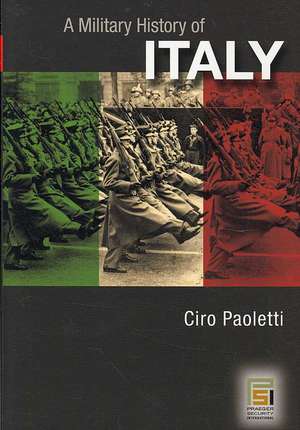A Military History of Italy
Autor Ciro Paolettien Limba Engleză Hardback – 29 dec 2007 – vârsta până la 17 ani
Preț: 463.64 lei
Preț vechi: 610.09 lei
-24% Nou
Puncte Express: 695
Preț estimativ în valută:
88.72€ • 94.87$ • 73.97£
88.72€ • 94.87$ • 73.97£
Carte tipărită la comandă
Livrare economică 17 aprilie-01 mai
Preluare comenzi: 021 569.72.76
Specificații
ISBN-13: 9780275985059
ISBN-10: 0275985059
Pagini: 296
Dimensiuni: 156 x 235 x 27 mm
Greutate: 0.61 kg
Editura: Bloomsbury Publishing
Colecția Praeger
Locul publicării:New York, United States
ISBN-10: 0275985059
Pagini: 296
Dimensiuni: 156 x 235 x 27 mm
Greutate: 0.61 kg
Editura: Bloomsbury Publishing
Colecția Praeger
Locul publicării:New York, United States
Notă biografică
Ciro Paoletti teaches at the State University La Sapienza of Rome. He is co-author of the Italian Official Histories. He has numerous publications and publications in both English and Italian.
Cuprins
AcknowledgmentsIntroductionPART I: THE SIXTEENTH CENTURY1 Before the Deluge2 The Italian Wars in the Early Sixteenth Century3 Between France and the Muslims: 1565-1601PART II: THE SEVENTEENTH CENTURY4 The Thirty Years' War in Italy5 The Second Half of the Century6 The League of Augsburg: 1690-1696PART III: THE EIGHTEENTH CENTURY7 The Spanish Succession: 1700-17138 The Second Morea War, the Quadruple Alliance, and theCorsican Troubles: 1715-17339 The Polish Succession: 1733-173910 The War of Austrian Succession: 1740-174811 Italy from the Corsican Rebellion to the French Revolution through the First Cold War: 1748-179212 The Revolutionary Hurricane: 1792-1799PART IV: THE NINETEENTH CENTURY13 Napoleon Emperor and King14 From the Restoration to the First War of Independence: 1816-184715 The First War of Independence: 1848-184916 From the Peace to the Second War of Independence: 1849-185917 Garibaldi in Sicily18 The New State19 The Kingdom, Royal Policy, and the Colonies, from Rome to Peking: 1871-1900PART V: THE TWENTIETH CENTURY20 Before the Great War: 1900-191221 The Great War: 1915-191822 From the Great War to the Ethiopian War23 "Overseas Spain" and "Overseas Tirana": 1936-193924 The War with the Germans: 1940-194325 The War Against the Germans: 1943-194526 Italian Armed Forces from World War II to the End of the Cold War: 1946-198827 Italy and NATO until the End of the Cold War28 From the Cold War to the War on Terror: 1989-2005NotesBibliographyMilitary Unit IndexName IndexPlace IndexA photo essay follows page
Recenzii
Paoletti contributes a much-needed modern military history of Italy. The author of a previous book focusing on army history, he incorporates over 8,300 sources and includes much on naval and air issues. Paoletti sets military development in the context of Italian social, economic, and political evolution to illuminate certain issues. The book opens with an overview of the medieval period and moves into the chaotic Renaissance era. Most of the first three sections concern the 16th-18th centuries, when Italy served as a perpetual battleground between France and the Hapsburgs and faced Islamic threats. The fourth section covers the 19th century, including the Napoleonic Wars and the unification process. Paoletti focuses much of his attention on the Piedmont's military and its role uniting the peninsula, the diplomacy that made it possible, and colonialism. The final section concerns the 20th century, with Italy's ill-fated participation in the world wars and its involvement in NATO and peacekeeping projects. In most cases, Paoletti tends to rate Italian military efforts higher than other authors have done, but he is critical when appropriate. Overall, this work is a valuable addition to European military historiography. Recommended. All levels/libraries.
[Paoletti's] thumbnail sketches of the Italian campaigns of the Second World War, and of the bloody years of civil war between 1943 and 1945 capture the complexityof Italy's misfortunes.
[Paoletti's] thumbnail sketches of the Italian campaigns of the Second World War, and of the bloody years of civil war between 1943 and 1945 capture the complexityof Italy's misfortunes.












